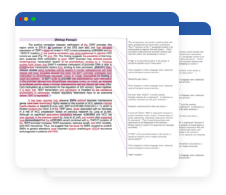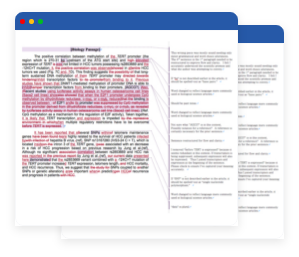Pronoun Types and Examples
A pronoun is a word that takes the place of a noun. A pronoun can act as a subject, direct object, indirect object, object of the preposition, or other part of speech and takes the place of any person, place, animal or thing. There are several types of pronouns: personal pronouns, relative pronouns, demonstrative pronouns, reflexive pronouns, interrogative pronouns, and possessive pronouns.
Types of pronouns
| pronouns Type | What it does | pronouns examples |
|---|---|---|
| Personal pronoun |
Refers to a person, place, thing or idea |
I, me, she, we, us, them, it, you, they |
| Relative pronoun |
Refers to another noun in the sentence to add further information |
Who, whom, whose, which, that, when, where |
| Demonstrative pronoun |
Refers to nouns that have already been mentioned |
This, that, these, those, such, none, neither |
| Indefinite pronoun |
Refers to nouns that are not specified or particular |
Anybody, everybody, nobody, somebody, anyone, everyone, no one, someone, anything, everything, nothing, something |
| Reflexive pronoun |
Self-refers to the subject and becomes the object of the sentence |
Myself, yourself, yourselves, ourselves, himself, herself, itself, themselves |
| Interrogative pronoun |
Introduces a question and asks about a specific noun |
Who, what, which, whose |
| Possessive pronoun |
Denotes possession or ownership of a noun |
My, our, your, his, her, its, their |
Table of Contents
Personal Pronouns
Personal pronouns are used to refer to a particular grammatical person: first person (I), second person (you), or third person (he, she, it, they). Personal pronouns also take different forms depending on the gender, number, and case of the noun it replaces. I, you, he, she, it, we they, me, him, her, us, and them are all personal pronouns.
- Example
- She is clever.
- Example
- Did you make a reservation for three?
- Example
- I hope you will invite them to the party.
Antecedents
Pronouns may refer to different persons or things ambiguously if the noun is not specified clearly in the sentence. When using pronouns in a sentence, an antecedent should be used to let the reader know what the pronoun is referring to. An antecedent is a noun or noun phrase that is mentioned at the beginning of a sentence and replaced with a pronoun afterwards.
- Example
- Sam drank most of the juice that he bought.
- Example
- The team has tried its best to achieve success.
- Example
- Many people lost their jobs because of the economic slowdown.
Unclear/ambiguous pronoun antecedents
- Example
- If you arrive late to the play, she won't let you in.
- Example
- Sam sent a letter to Mark addressing the problems he encountered during his first year at school.
Relative Pronouns
Relative pronouns are used to connect relative clauses and independent clauses in order to add more information about people and things. Relative pronouns are placed directly after the noun or pronoun they modify. Who, whom, whose, which, that, when, and where are all relative pronouns.
- Example
- Is the man who came to look for you your father?
- Example
- She likes books that tell stories of famous people.
- Example
- That store, where we usually buy our groceries, is closed for the holidays.
Who vs. whom: subject and object pronouns
When to use “who” or “whom” can be confusing. While both can be used as pronouns, their usage differs. “Who” is used to refer to the subject of a sentence, while “whom” is used to refer to the object of a verb or preposition.
- Incorrect
- Whom should be elected as the leader?
- Correct
- Who should be elected as the leader?
- Incorrect
- He is the person to who I am married.
- Correct
- He is the person to whom I am married.
- Incorrect
- You didn’t specify the officer who I should give this form to.
- Correct
- You didn’t specify the officer to whom I should give this form.
Demonstrative Pronouns
Demonstrative pronouns are used to refer to a specific person or thing within a sentence. These pronouns can be used to indicate degrees of time and space. This, that, these, those, such, none, and neither are all demonstrative pronouns.
- Example
- He is late again. That boy is really getting on my nerves.
- Example
- She loves all kinds of sports. These include badminton and soccer.
- Example
- I don't like math or science. Neither is fun.
Indefinite Pronouns
Indefinite pronouns are used to refer to unspecified or general people or things. Similar to “indefinite” articles, these pronouns are used to refer to indefinite people or things. Anybody, everybody, nobody, somebody, anyone, everyone, no one, someone, anything, everything, nothing, and something are indefinite pronouns.
- Example
- No one likes to have to beg for something.
- Example
- Everyone is welcome to join the class.
- Example
- Anything is possible only if you keep trying.
Reflexive Pronouns
Reflexive pronouns are used to refer back to the subject of the sentence. Reflexive pronouns end in "-self" (singular) or "-selves" (plural). Myself, yourself, yourselves, ourselves, himself, herself, itself, and themselves are reflexive pronouns.
- Example
- I saw myself in the mirror.
- Example
- The book itself isn't difficult, but it's not fun to read.
- Example
- They recommend this movie even though they have never seen it themselves.
Interrogative Pronouns
Interrogative pronouns are used to ask questions or find out more information. Who, what, which, and whose are interrogative pronouns.
- Example
- Which essay did you like the best?
- Example
- Whose bag is this?
Possessive Pronouns
Possessive pronouns are used to show possession or that something/someone belongs or is associated closely with someone/something. My, our, your, his, her, its, and their are possessive nouns. These pronouns can be used to avoid writing the same word twice and therefore can make sentences more concise.
- Example
-
I don't know where my sneakers went, so my sister lent me her sneakers.
I don't know where my sneakers went, so my sister lent me hers.
- Example
-
Your plan sounds just as exciting as my plan.
Your plan sounds just as exciting as mine.










